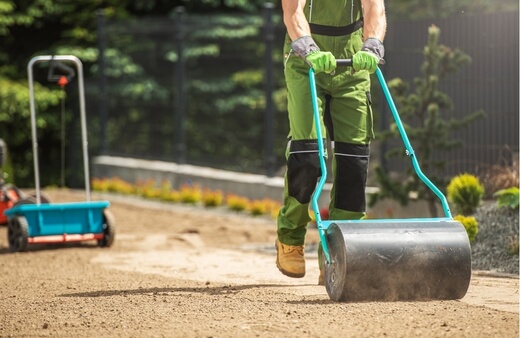Buffalo grass is a durable and verdant option for any Australian lawn, and is one of the most widely used grasses in the country for that very reason. If you’re wondering how to turn your plot into a grass-covered oasis, we’ve got you covered, with everything from advice on how and when to sow buffalo grass, to whether or not buying turf is a better option.
More...

Family: | Poaceae |
|---|---|
Genus: | Bouteloua |
Species: | B. dactyloides |
Common Names: | Buffalo Grass, Buffalograss |
Location: | Outdoor |
Type: | Lawn grass |
Growth: | 30cm tall if uncut |
Sun requirements: | 6 Hours of direct sun per day |
Foliage Colour: | Green |
Flower Colour: | Orange or yellow |
Flowering: | All year |
Fruit: | None |
Maintenance level: | High |
Poisonous for pets: | Non-toxic to cats and dogs |
What is Buffalo Grass?

Source: My Home Turf
Buffalo grass is the common name for Bouteloua dactyloides, a standard form of low-growing lawn grass that’s well suited to parks, recreational grounds, sports fields, and gardens. Buffalo grass works well in Australia thanks to its high tolerance for drought and humidity, and relatively low risk of fungal problems.
Another brilliant feature of buffalo grass is that it is quick to establish, and can look good from as little as four weeks from seed. Depending on your budget and timeframe, buffalo grass lawns can be prepared from seed turf with equally good success rates.
Natural Habitat of Bouteloua dactyloides
In the wild, like all grasses, buffalo grass behaves very differently from how it does in our gardens. It is native to North and Central America, from Canada to Mexico, and grows wild on prairies throughout the United States.
Like most grasses, it evolved due to natural deforestation and the adapted management of land by grazing animals. It doesn’t take a genius to realise that buffalos were a big part of its success.
If left uncut, buffalo grass grows to about 30 cm tall, with gorgeous waving orange flowers, later developing into copious amounts of seed. The taller the grass gets, the looser it becomes at ground level, so for pristine lawns, it’s important to regularly cut buffalo grass to maintain a thick thatch of ground cover.
How to Grow Buffalo Grass in Australia
One very important note about any buffalo grass seed or turf you can buy is that it will rarely be 100% buffalo grass. Most buffalo grass is difficult to germinate, and benefits from other grass species like rye grass to speed up germination and increase lawn thickness faster.
However, if you check with the retailer, or on packaging, good quality buffalo grass producers will list the quantity and percentage of seeds in each mix.
How to Prepare the Ground for Buffalo grass

Before you plant your lawn, it’s incredibly important to level your ground, and very gently tamp it down. While you can do this quickly with a rake, a tamper and a lawn roller, the best way is to take time, and react to divots that form over a week or so before sowing.
- Cultivate the area you plan to sow or lay turf onto down to at least 10cm.
- Tamp down, or step evenly over the entire surface to lightly compact it.
- Rake it over evenly once it is level to loosen to the surface layer.
- Wet the ground and leave it overnight.
- If bumps, divots, or hills form, correct them, and then wait again overnight for water to settle the surface.
- When you are happy with the surface, rake the whole area gently but evenly.
- You’re now ready to sow grass seed, or lay turf.
Drainage and Soil pH for Buffalo Grass
Buffalo grass prefers well drained soil with a little bit of water retention. Sandy soils will be fine with regular irrigation, but clay soils will need some preparation to improve drainage.
Even if you have incredibly poor drainage and clay soil throughout the garden, you can amend your soil to grow lush buffalo turf by digging sand through the top layer of soil (10-15cm deep), and aerating it regularly with a garden fork or lawn aerator.
Like most grasses, buffalo grass likes a fairly neutral pH, but slightly acidic is fine. Average Australian gardens have a pH of around 6.5 to 7, which is ideal. If you’re unsure you can buy soil testing kits online at little expense.
Light Conditions for Buffalo Grass
Buffalo grass needs 6-8 hours of sun per day to perform at its best, but don’t worry too much if you’ve got a shady corner. Provided it gets at least 4 hours of sun, there shouldn’t be a noticeable difference in performance over the year.


Get Your Free Guide:
Master Growing Australian Natives eBook
A Must Have Complete Guide for Every Australian Garden
Get Your Free Guide:
Master Growing Australian Natives eBook
A Must Have Complete Guide for Every Australian Garden
How and When to Sow Buffalo Grass
Any time through summer is the best time to sow buffalo grass, but it can actually be sown all year round in most parts of Australia. Provided the temperatures are above 15°C, buffalo grass will germinate.
If you do decide to sow your grass seed in summer, you’ll need to provide good irrigation, either with daily watering, or a good sprinkler set up.
- Prepare your ground (using the steps above)
- Rake neat drills through the soil so you can keep track of spacing.
- Sow buffalo grass seed at about 100g per 10m2, or 10g per m2 (a small handful).
- Rake over the area in both directions to cover the seed and reduce the uniformity of the rows.
- Water your lawn daily for at least two weeks.
Caring for Newly Sown Buffalo Grass
After sowing, it’s important to leave your lawn untouched. It will need regular watering, and plenty of sun, but do not feed it until it has properly established (after its first mow is the absolute earliest you should feed new lawns).
Do not walk on your lawn until after its first mow (4 weeks minimum, or when it reaches 2-3 inches tall).
How to Lay Buffalo Grass Turf
If you’re not prepared to wait that long for visually luscious lawns, you can buy buffalo turf in rolls, ready to roll out into the garden, but it’s essential that you treat it with the same care as you would with seed.
Just because it looks good, doesn’t mean it’s established, and buffalo grass turf can often take just as long to root firmly into the top soil as that sown from seed.
- Start by preparing the soil (exactly as you would for seed).
- Rake the surface so it is even and loose, and then lay backwards, raking the surface again if you have walked on it.
- If you need to lean on any section of turf while laying the next, use wide planks to spread your weight.
- Tuck the corners in neatly by overlapping each roll, and cutting through both ends for a perfect join (use the offcuts to fill in any awkward corners later).
- Thoroughly water your buffalo grass turf when you’ve finished and leave it overnight.
- Water daily for the first week, and then every two days in the second week.
- After three weeks, roots should begin to grip the topsoil (try pulling up a corner, if there’s resistance, it’s starting to take).
Caring for Newly Laid Buffalo Grass Turf
Once it has rooted, you can mow buffalo grass straight away (3-4 weeks after laying), and feed immediately after that to boost its vibrancy and help to establish any patches that are struggling.
Continue watering regularly for the first summer, and then return to normal watering routines (once or twice a week in summer, once in autumn, and only in dry spells during spring and winter).
Caring for Buffalo Grass Lawns
Once established, there are plenty of ongoing care considerations for buffalo grass. For instance, while it works brilliantly as a lawn turf, it’s an excellent candidate for meadow grass, allowing the establishment of flowering plants in and alongside it.
For standard care, buffalo grass should be regularly mown and watered, so follow the guide below for straightforward buffalo grass care advice.

Source: Hoffman Nursery
Watering Buffalo Grass
The simplest thing to consider with buffalo grass lawns in Australia is how often to water. Essentially, in warmer parts of the country, it will need weekly irrigation through summer, and twice weekly irrigation during heatwaves. In cooler parts of Australia, buffalo grass can survive on rain alone.
If you forget to water buffalo grass, it will start to look brown and patchy quite quickly, but it's worth remembering that it is well adapted to these conditions and can recover from very dire-looking situations when the weather improves.
What Fertiliser to Use
There are two ways to feed buffalo grass; granular fertiliser, and liquid feed. For granular fertiliser, you’ll need to invest in a good quality fertiliser spreader. For liquid lawn feed, any standard lawn feed will work perfectly well using mixers, or by hand mixing into watering cans for a slower but more water-efficient method.
How and When to Cut Buffalo Grass
Buffalo grass is a great option for neat lawns, as it can maintain a neatly cut appearance with fairly loose clipping. The ideal length for cutting buffalo grass is 2 inches, allowing it to grow to 3 inches before cutting.
Check out our reviews of petrol lawn mowers, robot lawn mowers, and electric lawn mowers for standard-sized gardens. And for bigger yards, consider investing in a ride on lawn mower or zero turn mower for a little bit of luxury. All the lawn mowers we recommend can be adjusted to suit the height of buffalo grass.
Cut buffalo grass only when it is dry. Cutting buffalo grass when wet can result in clogged mower blades, grass chutes, and your lawn may end up being ripped out in patches, rather than neatly clipped.
If you absolutely must cut your buffalo turf after wet weather, use a good quality petrol lawn mower, or ride on to reduce the risk of damage.After cutting, whip around the edges with a lawn edger for a perfect finish.
How to Repair Buffalo Grass Divots and Drainage Problems
Buffalo grass is well suited to high-traffic gardens, and is great for busy lawns with kids and pets too, because it is unlikely to deform, and its thatch fills in divots over time. However, if your lawn has developed large divots or mounds, you can manually rake them flat, or use a lawn leveller for more reliable results.
If drainage becomes an issue, walk sequentially in rows across your entire lawn, piercing with the full depth of your garden fork. Simply amending the drainage on puddling patches is not enough, as water will settle in new areas instead, so tackle the full job annually on poorly drained gardens.
Common Buffalo Grass Pests and Diseases
Buffalo grass is loved because it is low maintenance and mostly trouble free, so there is very little need to worry about pests and disease. However, there are a handful of pests, from moths to mealybugs that can cause fungal problems in your lawns, and introduce mould.
Treating your lawns with organic fungicides is often enough to deal with these problems, but if not, consider the cause, rather than the solution. There are few organic solutions to lawn pests, so it's best to look at what you can change, and wait for the problem to resolve.
Key care factors for buffalo grass that can cause pests and diseases include:
- Leaving grass clippings as mulch (this increases humidity and provides habitats for pests)
- Overfeeding (this will create an abundance of nutrients that the grass doesn’t need, and can actually harm it)
- Allowing puddles (this will trigger browning too early or late in the season)
- Allowing browning (summer can naturally dry out lawns, but when they are dormant and dry, they are more susceptible to all problems).
Buffalo Grass Frequently Asked Questions

Source: Lawn Solutions Australia
What is unique about buffalo grass?
Buffalo grass shares many traits with other grasses, but it is unique in its ability to cope with warm, humid conditions for long seasons, making it ideal for Australian gardens without much of the maintenance problems of more common grass seeds.
What are the negatives of buffalo grass?
If buffalo grass is allowed to dry out in summer, it has one big negative; it is not fire-safe. Buffalo grass can dry out excessively without dying and can allow the spread of fires in areas with high fire risks.
Does buffalo grass stay green in winter?
Buffalo grass will stay green through winter. It won't retain its full vibrancy from spring, summer, or autumn, but it will retain most of its colour and still look better than most grass varieties you can grow in Australia.
Does buffalo grass stop weeds?
Properly maintained buffalo grass slows the development of weeds, by providing a living mulch that blocks light and outcompetes annual weeds, and even some perennial weeds.
Is buffalo grass toxic to dogs and cats?
Buffalo grass is completely safe and non-toxic for dogs and cats. While you may notice your pets eating buffalo grass, and then vomiting, this is a natural instinct they have to clear indigestion or wind. They are not able to properly digest grass, so it acts as a sort of detox food when they are feeling unwell.
Is buffalo grass resistant to dog urine?
Buffalo grass is not resistant to dog urine, and there is no grass that is. Male dog urine will not have a major effect on lawns, but female dog urine will cause browning and dead patches on your lawn, regardless of the species, due to its highly acidic nature.
Does buffalo grass need a lot of water?
Buffalo grass is well suited to Australian gardens as it does not need a lot of water. In particularly warm parts of the country, it will need a maximum of 3 weekly waterings, and a total of 2” per week will suffice.
Can you lay buffalo turf over existing grass?
You should never lay new turf over existing grass, even if you have laid topsoil over the lawn. While the turf is attempting to establish roots, the old grass below will attempt to fight its way to the surface, often outcompeting for nutrients and slowing down the establishment of new turf.
What to do with buffalo grass in winter?
Buffalo grass needs little care during winter, and can often be left without mowing until spring. In warmer regions, your lawn will continue to grow slowly, but be largely dormant, so feed it at the end of autumn, and mow once a month if it is actively growing.
Wrapping Up Our Buffalo Grass Growing and Care Guide
Buffalo grass is generally regarded as one of the best lawn grasses for any part of Australia. Finding a reputable supplier can be challenging though, especially if you want pure buffalo grass. If that’s the case, it’s safer to opt for buffalo turf, as seed will nearly always be mixed.
Once you’ve got your seed or turf ready to go, just follow the guide above and you’ll have a healthy happy buffalo grass lawn in no time.
Published on February 4, 2023 by Maisie Blevins
Last Updated on February 22, 2025




